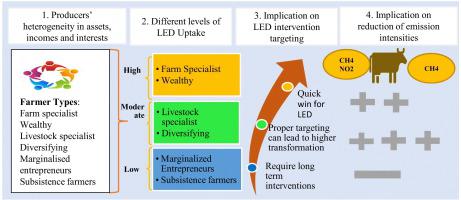Agricultural Systems ( IF 6.1 ) Pub Date : 2021-02-17 , DOI: 10.1016/j.agsy.2021.103073 E.M Kihoro , G.C. Schoneveld , T.A. Crane

|
Context
Reducing greenhouse gas (GHG) emissions from the agriculture sector – especially livestock – through low-emission development (LED) has attracted increased global attention. However, producers rarely prioritize emission reduction in their day-to-day practices, resulting in a mismatch between global and national environmental policies and local development interests. This raises the urgency of identifying overlapping solution spaces that would address global and national environmental targets and farmers' production goals.
Objective
The objective of this study is to identify pathways for scaling LED that better account for divergent smallholder capabilities, strategies, and interests.
Methods
A multivariate cluster analysis was used to evaluate producer heterogeneity. The analysis utilized data from 1176 household surveys in Tanzania. Informed by these results, stakeholder workshops were held to identify how each group is uniquely constrained in the adoption of LED practices and viable paths forward.
Results and discussions
Our results reveal six distinct farmer types, distinguishable by their asset base, livestock ownership, cattle breeds, access to market, and income diversity. The six groups presented three levels of LED uptake, high, moderate, and low. Variants of technological packages and market-based interventions, access to better quality inputs, and extension services will be more impactful when correctly matched to producers' asset portfolios, interests, and needs for the high and moderately intensifying producers. However, interventions that address both the knowledge and resource gaps for producers who demonstrate low uptake of LED will be more appropriate. Achieving GHG reduction will be modest from already intensifying groups and the low uptake groups, while moderately intensifying groups present the highest leverage for increased GHG reduction potential. This highlights how taking a food system approach rather than a technological package would be more beneficial especially in targeting groups that are not interested in LED.
Significance
This study challenges the conceptualization of LED as a simple technological fix. We demonstrate that LED, as currently conceptualized, is not equally accessible or appealing to everyone. Consequently, successful LED uptake is contingent on donor and state ability to match LED strategies, local development priorities, and food systems objectives to develop more targeted needs-driven implementation pathways.
中文翻译:

坦桑尼亚实现包容性低排放乳制品发展的途径:生产者异质性及其对干预设计的影响
语境
通过低排放发展(LED)减少农业部门(尤其是牲畜)的温室气体(GHG)排放已引起全球越来越多的关注。但是,生产者很少在日常实践中优先考虑减少排放,从而导致全球和国家环境政策与地方发展利益之间不匹配。这就迫切需要确定重叠的解决方案空间,以解决全球和国家环境目标以及农民的生产目标。
客观的
这项研究的目的是确定扩大LED的途径,以更好地说明小农户能力,战略和利益的差异。
方法
多元聚类分析用于评估生产者异质性。该分析利用了来自坦桑尼亚的1176个家庭调查的数据。根据这些结果,举行了利益相关方研讨会,以确定如何在采用LED做法和可行的前进道路上对每个小组进行独特的约束。
结果与讨论
我们的结果揭示了六种不同的农民类型,可以通过其资产基础,牲畜所有权,牲畜品种,市场准入和收入多样性来区分。六个小组展示了三个LED吸收水平,高,中和低。如果正确匹配生产者的资产组合,兴趣以及对中度集约化生产者的需求,则各种技术方案和基于市场的干预措施,获得更高质量的投入以及推广服务的影响将更大。但是,对于那些证明LED吸收率低的生产商来说,解决知识和资源缺口的干预措施将更为合适。在已经激化的人群和低摄入量的人群中,要实现减少温室气体排放的目标不大,而中等强度的人群则表现出最大的杠杆作用,可以增加减少温室气体的潜力。这凸显了采用食品系统方法而不是技术包将如何更加有益,尤其是在瞄准对LED感兴趣的人群时。
意义
这项研究挑战了将LED概念化为简单的技术解决方案。我们证明,按照目前的概念,LED并非所有人都能平等获得或吸引。因此,成功使用LED取决于捐助者和州政府是否有能力匹配LED策略,当地发展优先事项和食品系统目标,以开发更有针对性的需求驱动型实施途径。









































 京公网安备 11010802027423号
京公网安备 11010802027423号